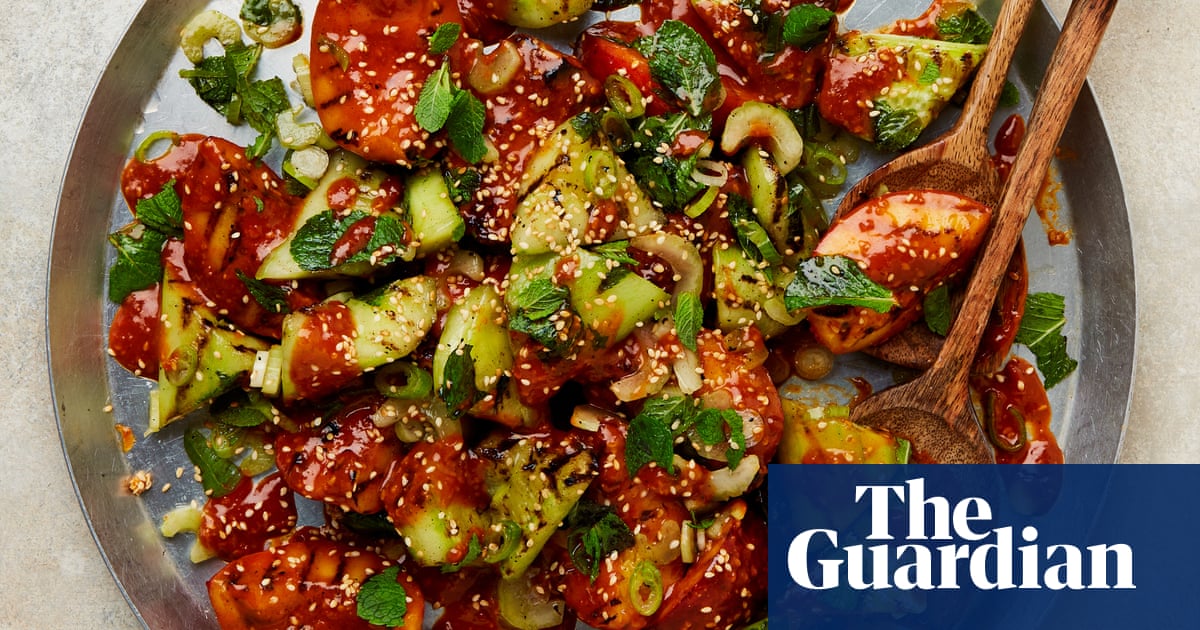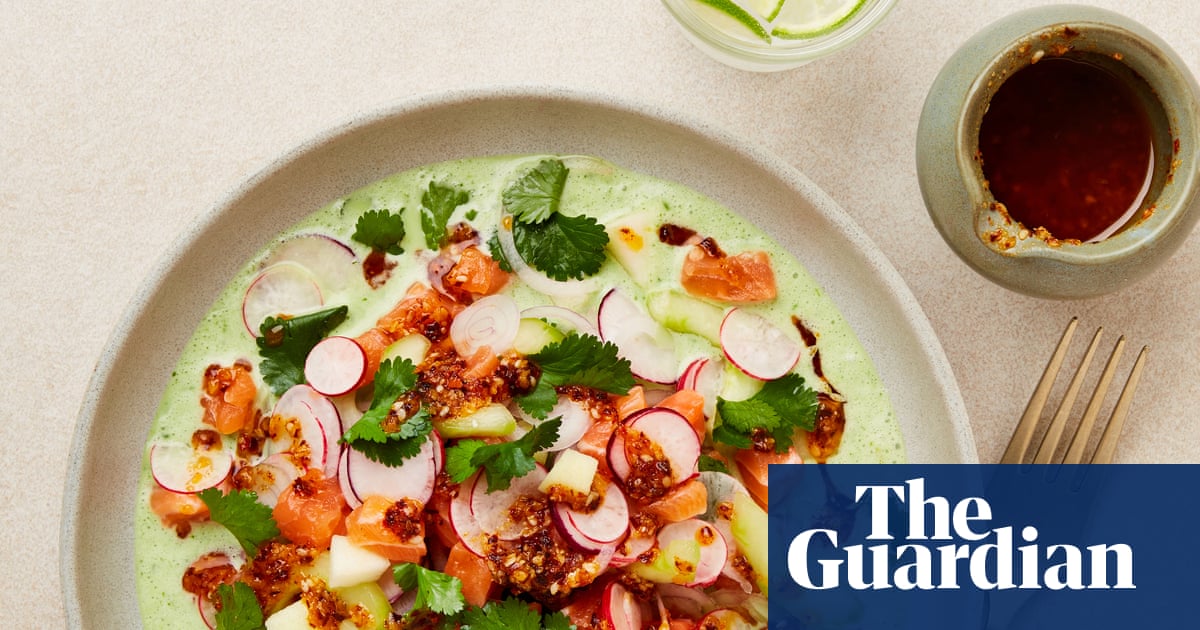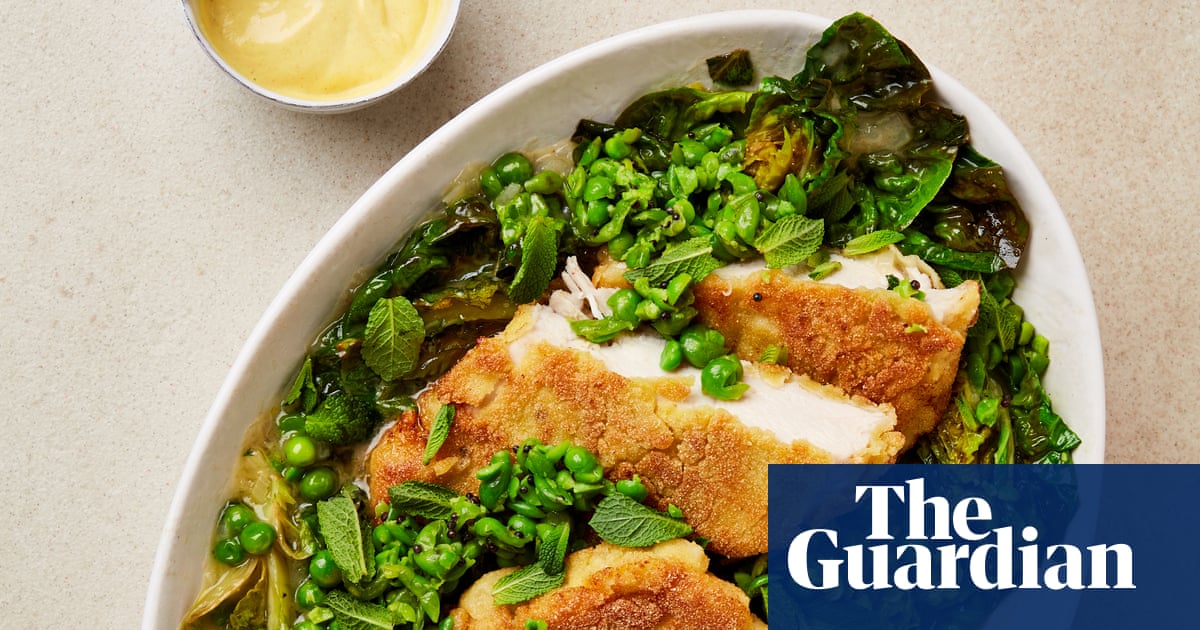
Ilove cooking with stone fruit: it’s so versatile, and as happy to keep its shape (brushed with oil and chargrilled, for example) as it is to be taken to the point of collapse in a hot pan. Either way, its natural sweetness is ready to be dialled right up and used in all sorts of chutneys and dressings. Chutneys, especially, being so sweet, tend to keep well, too, so make more than you need to have to hand for a few meals ahead.
Grilled nectarine and cucumber salad with gochujang dressing (pictured top)
This sweet and spicy dressing is a perfect match for grilled nectarines and cucumbers. The dressing is inspired by ssamjang, a Korean dipping sauce that’s often served with grilled meat. It can be made ahead and will keep for up to a week in the fridge, ready to be spooned over roast vegetables or stirred through noodles.
Prep 10 min
Cook 20 min
Serves 4 as a side
1 cucumber, peeled, cut in half lengthways, then cut into 4-5cm chunks
Fine sea salt
2 tbsp gochujang (Korean chilli paste)
4 tsp soy sauce
1 tsp caster (or granulated) sugar
1 garlic clove, peeled and crushed
4 tsp toasted sesame seeds
¼ tsp sesame oil
60ml olive oil
1 lime, juiced, to get 1 tbsp, plus 1 wedge extra to serve
3 nectarines or peaches, stoned and cut into quarters
1 stick celery, trimmed, peeled with a peeler, then very finely sliced
1 spring onion, trimmed and finely sliced
5g mint leaves, roughly torn
Put the cucumber in a sieve, sprinkle over a half-teaspoon of salt, toss to coat and set over a bowl.
For the dressing, put the gochujang, soy, sugar, garlic, three and a half teaspoons of the sesame seeds, sesame oil, two tablespoons of olive oil, lime juice and two nectarine quarters in a small food processor, blend for two minutes, to make a smooth paste, then transfer to a small bowl.
Put a griddle pan on a high heat. Rub the remaining nectarine quarters all over with a tablespoon of olive oil, then grill for a minute on each cut side, until they get nice char marks. Transfer the cooked fruit to the bowl of gochujang dressing.
Discard any liquid that has drained out of the cucumbers, then toss them with the remaining tablespoon of olive oil. Grill the cucumber pieces for a minute on each side, transfer to a bowl and leave to cool. Once cool, mix in the celery, spring onions and half the mint.
To assemble the salad, put the dressed nectarines on a serving plate, then top with the cucumber mixture. Drizzle over the remaining dressing, scatter on the remaining half-teaspoon of sesame seeds and the mint, and serve with the lime alongside.
Spiced pork chops with quick apricot chutney
This chutney keeps well in the fridge for up to a week, and pairs very well with all sorts: other fatty meat, such as duck, say, or really mature cheddar. The tarka lends it extra flavour and flourish. If you can’t find fresh curry leaves, the dish works well without them, too. Serve with plain rice or flatbreads.
Prep 10 min
Cook 30 min
Serves 4
4 x 350g thick-cut, bone-out pork chops, rind removed but fat left on
1 tbsp hot madras curry powder
Fine sea salt and black pepper
For the tarka
60ml olive oil
10 fresh curry leaves (optional)
1 tsp cumin seeds
1 tsp black mustard seeds
1 cinnamon stick
1 tsp aleppo chilli, or ½ tsp regular chilli flakes
For the chutney
1 red onion (150g), peeled, ½ finely chopped, the rest thinly sliced
20g ginger, peeled and finely chopped
1 mild green chilli (10g), halved, deseeded and finely sliced
6 apricots (210g), halved and stoned
2 tbsp caster sugar, plus a pinch extra for pickling
25ml apple or regular cider vinegar
To serve
10g coriander, leaves and stalks, roughly chopped
60g plain yoghurt, thinned with 1 tbsp water
Put the chops on a large plate, rub the curry powder all over both sides, then do the same with a teaspoon of salt and set aside to marinate.
Next, make the tarka. Put three tablespoons of oil in a medium saucepan for which you have a lid, and set it over a medium heat. Add the curry leaves (if using), cumin, mustard seeds and cinnamon, and cook for one to two minutes, until the mustard seeds start to pop and the curry leaves turn dark green. Meanwhile, put the aleppo chilli in a small heatproof bowl. Take the pan off the heat, carefully pour a tablespoon and a half of the oil and spice mix over the aleppo chilli, then set the bowl to one side.
Return the pan to the heat, stir in the chopped red onion, ginger, half the green chilli, the apricot halves and a quarter-teaspoon of salt, and cook, stirring occasionally, for five minutes, until the onions are soft and translucent. Stir in the sugar, 20ml vinegar, a quarter-teaspoon of salt, a good grind of pepper and two tablespoons of water, then cover and cook on a medium-high heat for 12 minutes, until the apricots start to break down. Take the pan off the heat and set aside.
While the apricots are cooking, in a small bowl mix the sliced red onion with the rest of the green chilli, the remaining teaspoon of vinegar and the coriander, add a pinch each of salt and sugar, then set aside.
Put a large frying pan on a high heat. Using tongs, hold the pork chops fat side down and upright in the hot pan and cook for two to three minutes, until the fat renders and forms a golden-brown crust (cook the pork in two batches, if need be). Lay the chops down on one side, add the remaining tablespoon of oil to the pan and leave to cook for three to four minutes, until the underside is deeply golden and slightly firm to touch. Turn the chops and cook on the other side for a minute or so more, until just sealed and golden. The meat should be firm to touch but dimple slightly when pressed. Once cooked, transfer the chops to a plate or tray and leave to rest for five minutes.
When ready to serve, carve the chops widthways into 3cm-thick slices and lightly season each slice with a pinch of salt. Transfer to individual plates and spoon some of the chutney over the sliced pork. Dollop the yoghurt on top, spoon some tarka over the yoghurt and serve with the sliced onion mixture on the side.
Roast beetroot with plum dressing and blue cheeseThis dramatic-looking dish makes great use of plums as a dressing, which is inspired by the Georgian dressing tkemali. Make extra, if you like, and serve with duck and other fatty meat, or with cheese. Feta would work as a substitute for the blue cheese, if need be.
Prep 25 min
Cook 35 min
Serves 2-4 as a side
500g beetroot, trimmed and cut into 3cm-thick wedges
1½ tsp maple syrup
1 tbsp olive oil
Salt and black pepper
20g toasted skinless hazelnuts, roughly chopped
¾ tbsp picked dill, roughly chopped
30g soft blue cheese, crumbled – we used Saint Agur
For the plum dressing
2 tsp olive oil
2 garlic cloves, peeled and crushed
3-4 plums (250g), peeled, cut into quarters, then each quarter cut in half
1 tsp maple syrup
¼-½ tsp regular chilli flakes, to taste
1 tsp fennel seeds, toasted and roughly ground
Heat the oven to 220C (200C fan)/425F/gas 7. Put the beetroot, maple syrup, olive oil and three-quarters of a teaspoon of salt in a medium bowl, toss to coat, then transfer to an oven tray lined with greaseproof paper. Bake for 25-30 minutes, stirring once halfway, until tender and slightly sticky.
To make the dressing, put the oil in a medium pan on a medium heat and, when it’s hot, add the garlic and cook, stirring, for 30 seconds. Add the plums, maple syrup, chilli, half the fennel seeds, a good grind of pepper and a quarter-teaspoon of salt. Cook gently for five minutes, until the plums release their juices and soften, but still hold their shape.
Take off the heat and, using a small spoon, lift out and set aside the larger pieces of plum. Keep the smaller, softer pieces in the pan, along with all the juices, then stir in the roast beetroot to coat.
Spoon the dressed beetroot mix into a shallow bowl, then top with the reserved larger plum pieces. Scatter over the remaining fennel seeds, the hazelnuts and the dill, and serve with the cheese dotted around and about the top.












